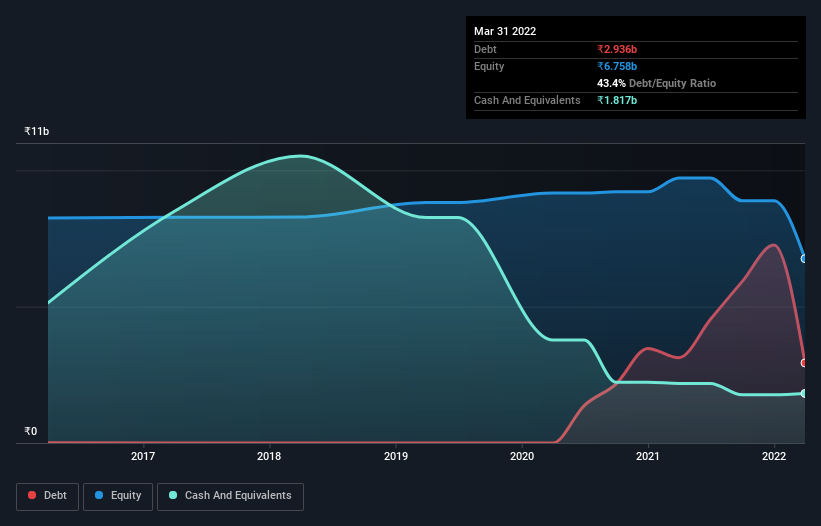
David Iben put it well when he said, 'Volatility is not a risk we care about. What we care about is avoiding the permanent loss of capital.' When we think about how risky a company is, we always like to look at its use of debt, since debt overload can lead to ruin. We note that GE Power India Limited (NSE:GEPIL) does have debt on its balance sheet. But should shareholders be worried about its use of debt?
When Is Debt A Problem?
Generally speaking, debt only becomes a real problem when a company can't easily pay it off, either by raising capital or with its own cash flow. Ultimately, if the company can't fulfill its legal obligations to repay debt, shareholders could walk away with nothing. However, a more usual (but still expensive) situation is where a company must dilute shareholders at a cheap share price simply to get debt under control. Of course, plenty of companies use debt to fund growth, without any negative consequences. When we examine debt levels, we first consider both cash and debt levels, together.
Check out our latest analysis for GE Power India
What Is GE Power India's Debt?
You can click the graphic below for the historical numbers, but it shows that GE Power India had ₹2.94b of debt in March 2022, down from ₹3.13b, one year before. However, because it has a cash reserve of ₹1.82b, its net debt is less, at about ₹1.12b.

How Healthy Is GE Power India's Balance Sheet?
According to the last reported balance sheet, GE Power India had liabilities of ₹26.1b due within 12 months, and liabilities of ₹1.75b due beyond 12 months. Offsetting these obligations, it had cash of ₹1.82b as well as receivables valued at ₹23.9b due within 12 months. So its liabilities total ₹2.05b more than the combination of its cash and short-term receivables.
Of course, GE Power India has a market capitalization of ₹10.6b, so these liabilities are probably manageable. But there are sufficient liabilities that we would certainly recommend shareholders continue to monitor the balance sheet, going forward. When analysing debt levels, the balance sheet is the obvious place to start. But you can't view debt in total isolation; since GE Power India will need earnings to service that debt. So when considering debt, it's definitely worth looking at the earnings trend. Click here for an interactive snapshot.
In the last year GE Power India had a loss before interest and tax, and actually shrunk its revenue by 22%, to ₹26b. That makes us nervous, to say the least.
Caveat Emptor
While GE Power India's falling revenue is about as heartwarming as a wet blanket, arguably its earnings before interest and tax (EBIT) loss is even less appealing. Indeed, it lost a very considerable ₹2.0b at the EBIT level. Considering that alongside the liabilities mentioned above does not give us much confidence that company should be using so much debt. So we think its balance sheet is a little strained, though not beyond repair. For example, we would not want to see a repeat of last year's loss of ₹2.9b. So to be blunt we do think it is risky. There's no doubt that we learn most about debt from the balance sheet. But ultimately, every company can contain risks that exist outside of the balance sheet. These risks can be hard to spot. Every company has them, and we've spotted 1 warning sign for GE Power India you should know about.
At the end of the day, it's often better to focus on companies that are free from net debt. You can access our special list of such companies (all with a track record of profit growth). It's free.
New: Manage All Your Stock Portfolios in One Place
We've created the ultimate portfolio companion for stock investors, and it's free.
• Connect an unlimited number of Portfolios and see your total in one currency
• Be alerted to new Warning Signs or Risks via email or mobile
• Track the Fair Value of your stocks
Have feedback on this article? Concerned about the content? Get in touch with us directly. Alternatively, email editorial-team (at) simplywallst.com.
This article by Simply Wall St is general in nature. We provide commentary based on historical data and analyst forecasts only using an unbiased methodology and our articles are not intended to be financial advice. It does not constitute a recommendation to buy or sell any stock, and does not take account of your objectives, or your financial situation. We aim to bring you long-term focused analysis driven by fundamental data. Note that our analysis may not factor in the latest price-sensitive company announcements or qualitative material. Simply Wall St has no position in any stocks mentioned.
About NSEI:GEPIL
GE Power India
Engages in the engineering, procurement, manufacturing, construction, maintenance, and servicing of power plants and power equipment in India and internationally.
Excellent balance sheet and good value.
Similar Companies
Market Insights
Community Narratives



